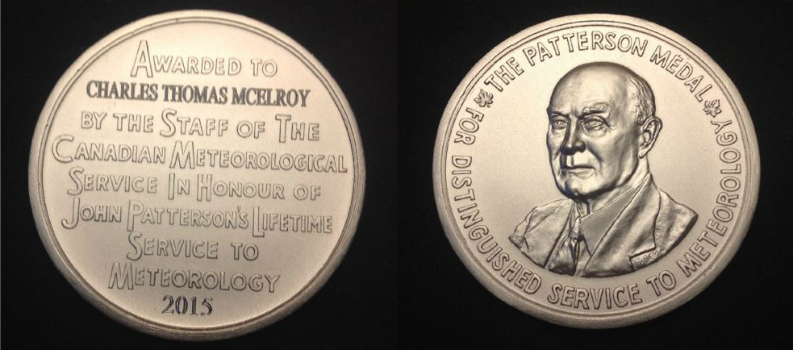The Patterson Distinguished Service Medal, presented since 1954, is considered to be the most pre-eminent award recognizing outstanding work in meteorology by a Canadian. This prestigious award is named in honour of Dr. John Patterson, a distinguished meteorologist who was Director and Controller of the Meteorological Service of Canada from 1929 to 1946, a crucial period in the development of Canada’s weather service.
David Grimes, the Assistant Deputy Minister of the Meteorological Service of Canada gave his appreciation: “For 45 years, Dr. McElroy has been a leading member in Canadian and International meteorological science through advancements in research and technology in the field of atmospheric studies. Key accomplishments made while working for Environment Canada include: co-invention of the Brewer Ozone Spectophotometer and designing of the Double-Brewer, the most accurate ground-based instrument in the Global Ozone Observing System; development of the Composition and Photodissociative Flux Measurement for the NASA ER-2 High-altitude Ozone Chemistry Program, which was critically important for confirming the theory behind the ozone layer and its recovery; and, co-invention of the UV index, which has increased awareness to protect against the harmful rays of the sun to minimize the risks of skin cancer worldwide. Following 36 years as a Research Scientist for Environment Canada, Dr. McElroy retired from the public service in 2011 to become Professor and an Industrial Research Chair in Atmospheric Remote Sounding at York University, where he provides leadership in the design, building and deploying of new and innovative remote-sounding instruments.
His leadership on a national and international meteorological research platform and his mentoring of students and colleagues demonstrates his scientific excellence and achievements, all qualities that make him an outstanding recipient of the Patterson Medal.
Please join me in congratulating Dr. McElroy for his dedicated service and distinctive contributions to meteorology in Canada and around the world.”
After receiving the Patterson Medal Dr. McElroy addressed the audience at CMOS:
“My collegues et mes amis, cet un plaisir singulier d’être ici pour accepter la médaille Patterson. To start, I want to thank the Meteorological Service and Environment Canada for awarding me the Patterson medal. It is very important that we recognize the contribution that science makes to our society. For those of you who do not know me, I had a long - 36 years - productive and enjoyable career as a research scientist with EC. I am indebted to my many colleagues for the support I received throughout that time. I would like to thank Paulina Karwowska-Desaulniers and Shabnam Nikfar of the Dean’s office at York for organizing the nomination for the Patterson, Michel Beland for making the nomination and those who provided letters of support for the nomination including Gordon Shepherd, Bob Evans, Irina Petrapavlovskikh, Alkis Bais, Johannes Staehelin and AnnaMaria Siani.
I would like to share a few thoughts based on my 45 years of active experimental research in Canada. I began my research career in second year at the University of Toronto. Alan Brewer - of the Brewer-Dobson circulation - Jim Kerr and I developed a spectrometer to measure NO2 in the stratosphere. There was a grave concern at the time that supersonic passenger jets would destroy the ozone layer by injecting NO and water vapour into the stratosphere. I flew on Concorde 002 while it was still an experimental aircraft in 1973 to make occultation measurements of NO2. The pilots still had ejection seats!
Jim Kerr, David Wardle and I developed the Brewer Ozone Spectrophotometer, the UV Index and the UV Index forecast. This is the most visible public impact of our research. The Brewer is now in use in 45 countries and 25 countries use the UV Index, which became an international standard through the United Nations Environment Programme (UNEP).
Clearly, climate change is the greatest threat to the survival of our species. In my new career as a professor at York University, I am pursuing the development of an instrument to fly on a satellite and measure methane and carbon dioxide in the Arctic. If we haven’t managed to make sufficient progress on climate change in the next 5 or10 years images, of GHGs coming out of the melting permafrost may provide the kind of impetus for change that the TOMS ozone maps did for ozone depletion.”
